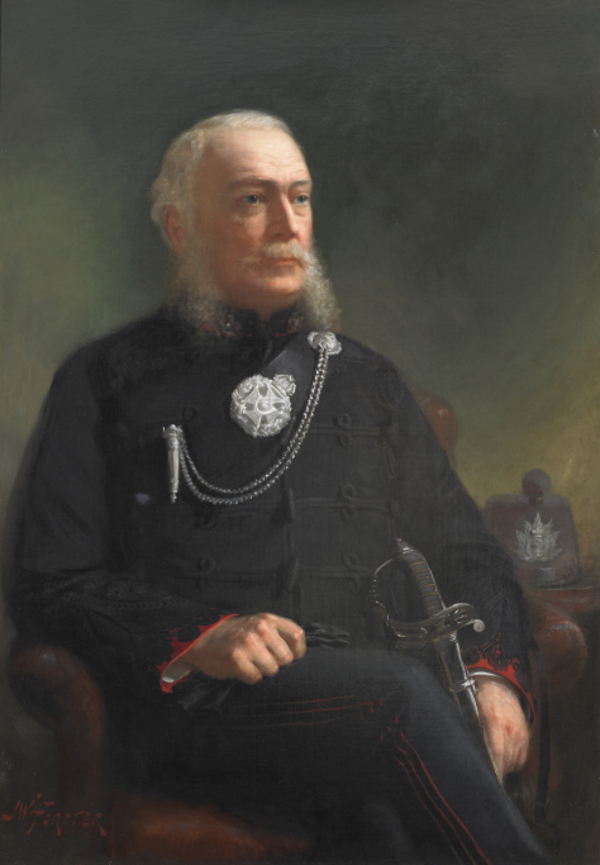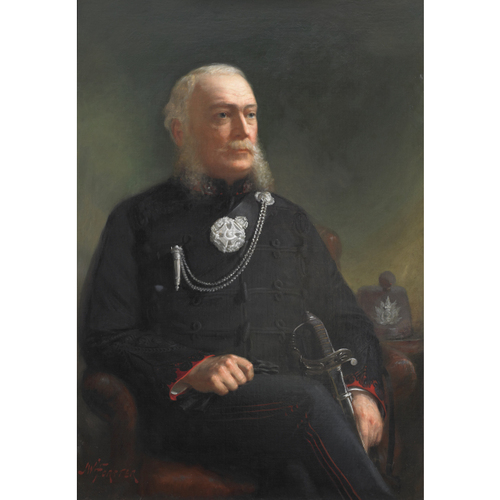
Source: Link
DURIE, WILLIAM SMITH, militia officer; b. in 1813 at Gibraltar, son of William H. Durie, an army surgeon, and Helena Lee, sister of Sir Francis Lee; he and his wife Anna* had one son and daughter; d. 3 June 1885 at Toronto, Ont.
William Smith Durie graduated from the Royal Military College, Sandhurst, England, in 1828. He was commissioned ensign in the 94th Foot on 20 Jan. 1832 and transferred to the 83rd Foot on 11 Aug. 1837 when it was ordered to Canada. On 18 May 1838 he obtained permission to sell his lieutenant’s commission on the grounds of ill health. He received a largely honorific commission as captain in the sedentary Canadian militia on 28 Nov. 1838.
After serving in Canada, Durie’s father had retired from the army and as an assistant inspector of hospitals on 14 June 1836. He obtained land grants in Upper Canada in the townships of Collingwood, Sunnidale, and Plympton in recognition of his rank and his 38 years of service. From 1838 to 1855 William Smith Durie lived in Thornhill, Toronto, and Barrie, presumably managing his own land and that of his father, but little is known of his life in these years. In 1856 he was affluent enough to own a schooner valued at £300 which he docked on Lake Simcoe.
In 1855 Durie had resumed more active military life as captain of the Barrie Rifle Company, an early unit in Canada’s new volunteer militia. Inspired by the military excitement of the Crimean War and modelled on militia systems in some American states, the volunteer units were expected to fulfil a police role. In September 1856 Durie and 20 of his men rushed to Collingwood when sailors rescued a comrade from the authorities. The sailors escaped on their vessel but Durie and his men received official thanks for their efforts. Because of his seniority Durie was promoted lieutenant-colonel on 11 Dec. 1856.
That year, in preparation for the visit of the Prince of Wales, militia companies in Montreal and Toronto were formed into battalions. Durie assumed command of the Toronto corps which included companies in Barrie and Whitby as well as six in Toronto (two of which wore Highland dress). Since companies elected their own officers and purchased their own uniforms and equipment, Durie needed tact and patience as well as military experience to unify his command. The unit, created 26 April 1860, was first known as the 2nd Battalion Volunteer Militia Rifles; Durie secured the title 2nd Battalion, Queen’s Own Rifles of Toronto on 18 March 1863. He drafted standing orders, badgered authorities for a drill shed, which was completed in June 1864, and struggled to standardize uniforms and arms. The result was probably the best organized militia unit in Canada.
Durie’s task was made easier by the recurrent alarms of the 1860s, from the Trent affair to the Fenian raids. In the winter of 1864–65 he was chosen to command a battalion of embodied militia at Niagara-on-the-Lake. His success as an administrator and disciplinarian helped to win him the appointment of assistant adjutant-general for Canada West on 15 Nov. 1865. He did not formally relinquish command of the Queen’s Own until 14 Sept. 1866 but he was performing only staff duties in Toronto when the battalion was part of the militia force under Alfred Booker* which suffered a humiliating defeat by the Fenians at Ridgeway on 2 June 1866.
In the post-confederation militia, Durie was appointed deputy adjutant-general for the 2nd Military District which included Toronto, Hamilton, and central Ontario. This area had a heartier appetite for patriotic military activity than did most other parts of Canada, and whereas many staff officers treated their positions as sinecures Durie was regarded as conscientious and popular. In 1871 he was almost alone among militia staff officers in urging that the volunteer system remain the basis for recruiting: “The record of the past shows that the existing force has cheerfully met all the active service duties required of it and that, too, with no ordinary sacrifice to a large proportion of the members composing the force.”
Durie’s own zest for service had to be satisfied by commanding the militia during disturbances at Toronto in the fall of 1875, known as the “Jubilee Riots,” when Protestant roughnecks attacked Catholic processions on two successive Sundays, and also by participation in an expedition by part of his old regiment to Belleville in early January 1877 to oppose the striking locomotive engineers of the Grand Trunk Railway. In 1880, over his bitter objections, he was superannuated at the age of 67 with two years pay but without a pension. Four years later, the old soldier was father to a daughter.
At some sacrifice to his private fortune, Durie showed that Canada’s volunteer militia system could work but that it would depend on the willing sacrifice of a minority. In the Queen’s Own Rifles he gave the volunteers a model unit.
PAC, RG 8, I (C ser.), 769: 41, 45; 1000: 125, 136; RG 9, II, A1, 149: no.6885. Queen’s Own Rifles Regimental Museum (Toronto), William Smith Durie papers. Can., Dept. of Militia and Defence, Report on the state of the militia (Ottawa), 1868–80. Globe, 4 June 1885. Northern Advance and County of Simcoe General Advertiser (Barrie, [Ont.]), 7 Aug., 11 Sept. 1856. Toronto Daily Mail, 4 June 1885. W. T. Barnard, The Queen’s Own Rifles of Canada, 1860–1960: one hundred years of Canada (Don Mills, Ont., 1960). Desmond Morton, The Canadian general: Sir William Otter (Toronto, 1974).
Cite This Article
Desmond Morton, “DURIE, WILLIAM SMITH,” in Dictionary of Canadian Biography, vol. 11, University of Toronto/Université Laval, 2003–, accessed December 31, 2025, https://www.biographi.ca/en/bio/durie_william_smith_11E.html.
The citation above shows the format for footnotes and endnotes according to the Chicago manual of style (16th edition). Information to be used in other citation formats:
| Permalink: | https://www.biographi.ca/en/bio/durie_william_smith_11E.html |
| Author of Article: | Desmond Morton |
| Title of Article: | DURIE, WILLIAM SMITH |
| Publication Name: | Dictionary of Canadian Biography, vol. 11 |
| Publisher: | University of Toronto/Université Laval |
| Year of publication: | 1982 |
| Year of revision: | 1982 |
| Access Date: | December 31, 2025 |



